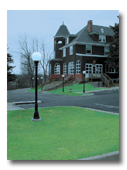The Fredericksburg Economic Development Authority hosted its first-ever developers’ forum under the banner of JumpStart! Fredericksburg. Speakers from around the state told of their successes in redeveloping historic properties into mixed use properties that add to the vitality of their urban communities. Some examples:
- In a $5 million project, Fairfax Hall, a former girls’ school in Waynesboro, was converted into 50 apartments with a large space for commercial use for social functions, weddings and the like.
- The 1907 Railway Express Building in downtown Fredericksburg was refurbished into offices and a restaurant.
- The old John Marshall Hotel in Richmond was converted into 175 residential units, with conference space in the lower level.
JumpStart has hired an Annapolis consultant to develop drawings of 14 areas of Fredericksburg to visualize what smart development could look like. According to the Free Lance-Star: “About 50 local developers turned out for sessions on historic rehabilitation tax credits, mixed-use development, and incentives that have fueled dozens of projects around the state.”
(Photo credit for Fairfax Hall photo: Waynesboro Redevelopment & Housing Authority)


Leave a Reply
You must be logged in to post a comment.